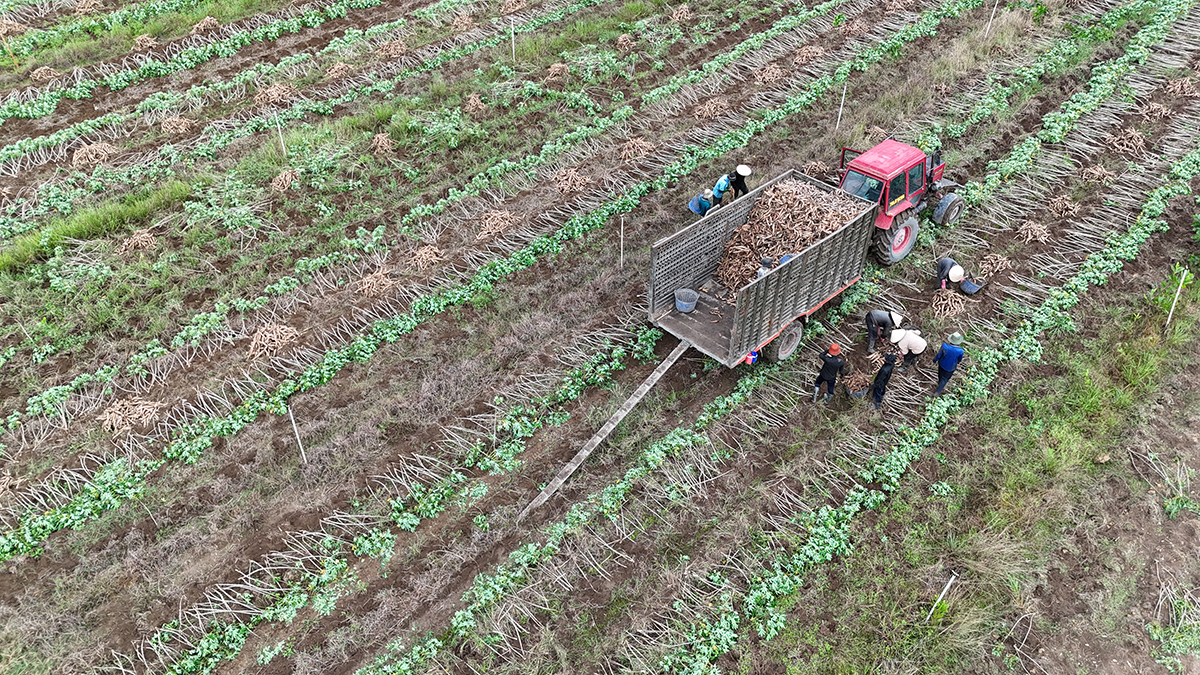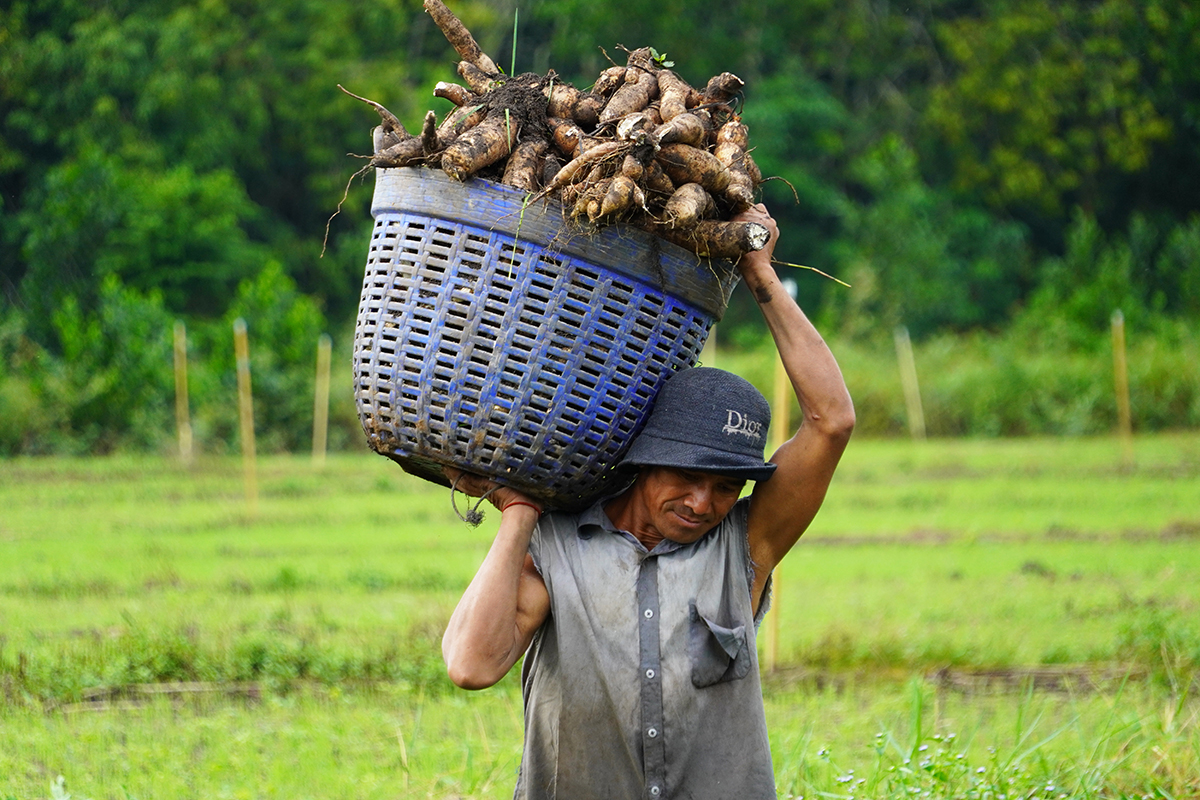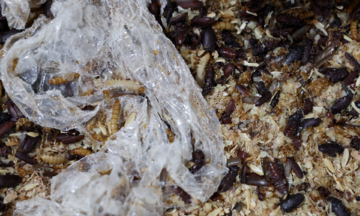On a September morning, 50-year-old Nguyen Thanh Tung joined a group of workers harvesting cassava in Tan Hoi commune. Tung has over 10 years of experience cultivating cassava. He plants one crop annually, typically starting in the 10th lunar month and harvesting after six months.
 |
Workers and a tractor collect cassava at Vu Tai Quang's field on the morning of 4/9. Photo: Hoang Nam |
Workers and a tractor collect cassava at Vu Tai Quang's field on the morning of 4/9. Photo: Hoang Nam
During this same period in previous years, cassava with a 30% starch content fetched between 3,000 and over 4,000 dong per kilogram. Farmers invest approximately 30 million dong per hectare. With yields ranging from 30 to 40 tons per hectare, they typically profit between 50 and 120 million dong after deducting expenses.
Anticipating similar profits, Tung leased additional land this year, totaling over 30 hectares including his own, at a cost of nearly 30 million dong per hectare per season.
This season, the region's main cassava varieties, such as KM505, HN1, and KM140, yielded well, averaging 35 to 38 tons per hectare, with some areas exceeding 40 tons.
Despite the bountiful harvest, Tung and many other farmers find themselves in the frustrating situation of "abundant harvest, low prices."
Since the beginning of the year, cassava prices have continuously decreased, ranging from 1,500 to 1,900 dong per kilogram. Except for those farming their own land and offsetting losses with their labor, most farmers leasing land are experiencing significant losses.
"After calculating fertilizer, medicine, and labor costs, I estimate a loss between 100 and 200 million dong this season," Tung stated.
Five kilometers away, 34-year-old Vu Tai Quang and a team of 10 workers were also harvesting and loading cassava onto trucks. Quang has been a cassava trader for over 10 years. Each year, at the start of the season, he assesses the young cassava plants and pays farmers upfront, ranging from 30 to 50 million dong per hectare depending on quality. This year, Quang purchased approximately 100 hectares of cassava.
He typically hires workers to harvest and transport 20 to 30 tons of cassava daily from the fields to a factory 10 kilometers away.
"I bought the young cassava at a high price, but now the harvest price has dropped, resulting in a loss of 5 to 7 million dong per hectare this season," Quang explained.
 |
Hun Son and his team harvest cassava. The wage is 300,000 dong per ton. Photo: Hoang Nam |
Hun Son and his team harvest cassava. The wage is 300,000 dong per ton. Photo: Hoang Nam
Many farmers say this is the first time in nearly 10 years that cassava prices have dropped so drastically. Facing these losses, the cost of labor and harvesting has become another major concern.
Because cassava harvesting is labor-intensive, most workers are Khmer people living in the border area.
45-year-old Hun Son, a Khmer man, has worked with his wife and son harvesting cassava for over 10 years.
To make the most of the cooler hours and avoid the heat, they start work at 1 a.m., using headlamps. The harvesting is usually completed by 6 a.m., followed by cutting the stems, piling the cassava roots, and loading them into baskets for transport by tractor.
On average, one person can harvest about two tons of cassava per day, earning 300,000 dong per ton.
"My family earns nearly 2 million dong per day, and we're paid weekly," Son shared.
This season, Tay Ninh province has over 46,200 hectares of cassava, mainly concentrated in the communes of Tan Chau, Tan Hoi, Tan Phu, Tan Thanh, Tan Hoa, and Tan Dong. Tay Ninh is one of the provinces with the largest cassava cultivation areas in the country. To date, farmers have harvested over 18,300 hectares, with an average yield of over 33 tons per hectare.
Dinh Thi Phuong Khanh, Deputy Director of Tay Ninh's Department of Agriculture and Environment, attributes the price drop to limited export markets.
 |
Cassava prices have fallen by approximately half, leading to losses of 10 to 20 million dong per hectare for farmers leasing land. Photo: Hoang Nam |
Cassava prices have fallen by approximately half, leading to losses of 10 to 20 million dong per hectare for farmers leasing land. Photo: Hoang Nam
Approximately 90% of Vietnam's cassava production is exported to China. Recently, China has reduced its import of cassava chips due to its economic slowdown. With lower global corn prices, Chinese animal feed processing plants have increased their use of corn as a substitute for cassava chips, significantly reducing demand.
Additionally, high cassava prices in recent years led to expanded cultivation and increased supply, putting downward pressure on prices when export markets face challenges.
To avoid this recurring cycle of "bumper crop, falling prices," the provincial agricultural sector is working to promote trade and explore new export markets beyond China to reduce dependence. Local authorities are also supporting and connecting local processing enterprises with farmers to establish stable production and consumption chains, ensuring a stable outlet for cassava products. Domestic enterprises are encouraged to increase their use of domestic cassava starch in products like E5 and E10 biofuels, replacing imported materials.
Hoang Nam












